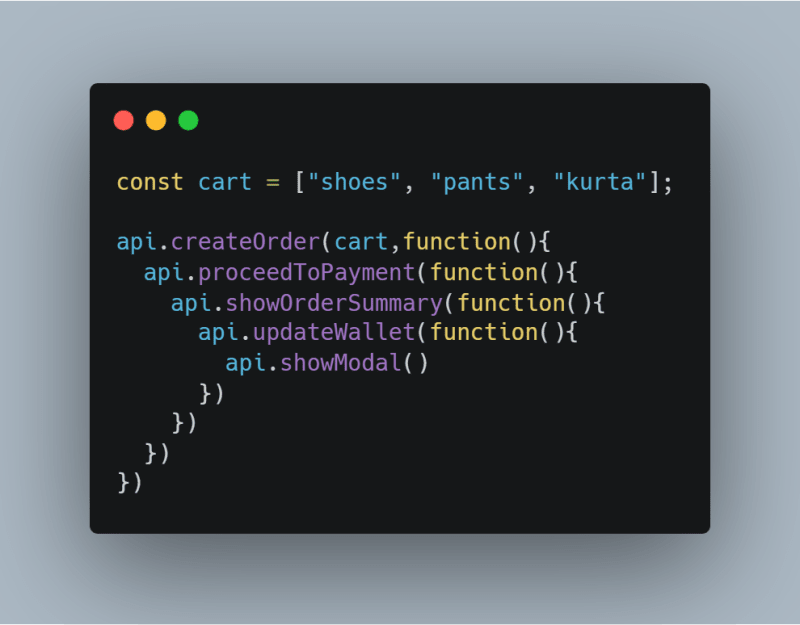Callback Hell and Promises

Md Anas Sabah
Posted on April 3, 2023

For understanding the concept of Callback Hell, I think you should know about Callback.
What is Callback?
Callback is a powerful way to do asynchronous thing in JavaScript. It is a function which is to be executed after another function has finished execution.
Suppose, we have an E-commerce Application where we have createOrder and proceedToPayment function which have to execute one after another respectively.
We have dependency between those two , We can manage those dependency in our code using callback because it's an async operation.
When JavaScript Engine executes this code it will just call the createOrder api.
Now it is responsibility of createOrder function to callback proceedToPayment api
Issues with Callback
1. Inversion of Control
2. Callback Hell
Inversion of Control
Inversion of control is like you loose the control of code when you are using callback.
Callback Hell
You are seeing now a nesting of functions here and code also looks scary and this is what we called Callback Hell. For a big application it creates more nesting.
To avoid this, we will see now Promises.
Promises
To fix the issue of Inversion of Control and Callback Hell, ES6(ECMAScript 6) Promise is the easier way to work with asynchronous programming in JavaScript.
A promise acts as a container for a future value.
For Example: const promise = createOrder(cart)
Whenever JavaScript engine executes this line, this createOrder api will return us a promise.(Promise is nothing but an empty object) and program will just go on and execute.
But after fetching data from API, promise object get filled automatically.
Now how will we attach our callback to that promise?
We will use .then method.
promise.then(function(orderID){
proceedToPayment(orderID);
});
This callback function runs automatically after fetching data from api in the promise object.
A Promise is an object representing the eventual completion or failure of an asynchronous operation.
There are three states of promise:
1.pending
2.fulfilled
3.rejected
Promise Chaining
Taking example of callback hell we can also do promise chaining

We always return a promise from a promise, when we are chaining it
Create a Promise
Consumer Part
const cart = ["shoes", "pants","kurta"];
const promise = createOrder(cart);
promise.then(function(orderID){
proceedToPayment(orderID);
});
Producer Part:
function createOrder(cart){
const pr = new Promise(function(resolve,reject){
//create order
//validate cart
//orderID
if(!validateCart(cart){
const err = new Error("cart is not valid")
reject(err);
}
const orderID= "1234"
if(orderID){
setTimeOut(function(){
resolve(orderID);
},5000);
}
});
Thanks for reading this long post! I hope it helped you understand these topics a little better. If you liked this post, then please do give me a few ❤️ and share it if you can. You are welcome to
give any suggestions in comments and ask anything!

Posted on April 3, 2023
Join Our Newsletter. No Spam, Only the good stuff.
Sign up to receive the latest update from our blog.




